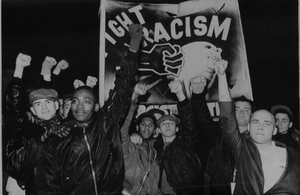Providence Rebellion
The Providence Rebellion were a series of clashes and riots that took place mostly in Providence, Rhode Island, with smaller fighting in Boston, Hartford, Springfield, Worcester and several smaller towns from 6 April to 15 April, 1980. The fighting was a direct result of the UCA's secession from the United States a month prior. The fighting was waged between Federal Loyalists, pro-Commonwealth forces, with left-wing forces engaging both in some instances.
Background
See Also: Collapse of the United States
In the year after the Three Mile Island meltdown, witnessing the evacuation to of the US government to the west and suspension of American democracy by a military committee, most states beyond the rockies began to rarely get any aid or support at all, with New England getting much of its support from the United Kingdom and Canada. Politics in the region, like the rest of the country, became increasingly polarized. Loyalists, Independence groups, Socialists, Revolutionaries, Counter-revolutionaries and others regularly fought each other in the streets, with Boston resident S. Malone comparing it to "Berlin in 32". By March, with the one year anniversary of the meltdown approaching, the 6 New England states met in the Hartford Convention[1], proclaiming their unilateral secession. The secession had effectively lit the fuse for the loyalists, with a National Guard garrison attempting to seize Boston.
Provisional Government established
In the morning hours of March 9th, the Communist Party, which had grown to a staggering number of members in the past year, called for a general strike across the new nation. On the tenth, the revolutionary militias launched an attack on Providence, storming the state government and attempting to force governor Joseph Garrahy to proclaim his loyalty to the revolution after learning of his intention to meet with the Soviet government on arms reduction before the secession. Outwardly refusing, Garrahy was taken hostage by the revolutionaries. On the 11th, Provisionals seized the WPRO radio station, and began broadcasting orders for a general rising. On the 12th, red militias overtook Worcester.
Attack on Devens
Extremely Ill equipped and inexperienced yet filled with revolutionary fervor, the Worcester Provisional Government ordered a direct assault on Leominster, with revolutionary militias marching north and taking the city with little to no resistance. Having no contact with Providence, the WPG continued their march, seizing Fitchburg and Lunenburg in the next two days. The newly established New Englander government began scrambling for a response. General George S. Patton IV offered his services to the Hartford Convention
Command of George Patton IV
Collapse of the Communist Party
Battle of Worcester
Surrender of Providence
Federal Insurgency
- ↑ Actually in Boston. Named for the New England secessionist convention during the War of 1812, also called the Hartford Convention.
